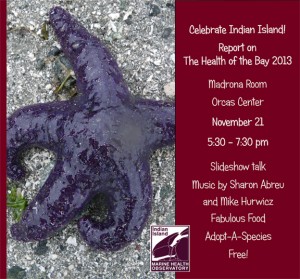— from Russel Barsh of Kwiáht —
Thursday, Nov. 21, 5:30 – 7:30 p.m., Orcas Center
Indian Island volunteers make their annual report on the health of Indian Island and celebrate five years of community monitoring and stewardship on Thursday evening November 21, 5:30 to 7:30 pm, at Orcas Center. Enjoy a slideshow by Kwiáht director Russel Barsh, displays by local students, a musical medley by Sharon Abreu and Mike Hurwicz, a light savory buffet by the Orcas Store, desserts made by community scientists, and special opportunities to contribute to the conservation of Indian Island as a donor or a volunteer. The event is family friendly and admission is free.
This year volunteers invite you to adopt one of Indian Island’s rare and charming fish, birds, or marine invertebrates as your own special New Year’s project. For a modest donation, you will receive a button featuring your choice of Indian Island “foster child,” and personal updates on its status and current research. For a little more, there will be a number of exclusive naturalist talks and picnics, and recognition in future Indian Island publications and events.
“Never has the need for community participation been greater,” says Indian Island program coordinator Kelly Rose. Summer visitors have been increasing since the Indian Island program began in 2009. In addition to monitoring marine life, wildflowers, and birds, volunteers personally greeted over 4,100 visitors to the island in 2013. Volunteers also built a “driftwood trail,” distributed field guides, supervised school groups, rescued stranded wildlife, and helped prevent visitors from being stranded by flood tides.
The driftwood trail has been an unqualified success, Barsh says. “Wildflowers on most of the island are already recovering.” At the end of the 2013 season, moreover, the Indian Island program and Orcas Island Youth Conservation Corps carefully removed a truckload of English ivy, Himalayan Blackberry and other invasive plants by hand.
Seasonal restrictions to protect nesting seabirds were successful in 2012, but when restrictions were eased in June 2013 so that visitors could watch nests from a high point on the island, Black Oystercatchers lost all their eggs to predators and did not lay another set. “We’re still looking for the right balance of public enjoyment and seabird survival,” Rose says.
Another concern is a four-year decline in Bay pipefish, which Barsh says may be due to an outbreak of a parasitic copepod that attaches itself to gills. “At this stage, it’s more likely that pipefish are dying from parasites than from contaminants, but toxics can depress the immune system of fish and leave them less able to survive parasitism.” Other indicators of ecosystem health, such as eelgrass density, have remained steady, however.
The task of monitoring contaminants for the Indian Island program has been given to Orcas students.
Kwiáht is working with Laura Tidwell’s Orcas Middle School students on a novel approach to monitoring lubricating oils and other automotive contaminants in Eastsound street runoff. Bundles of polypropylene fabric are hung in storm drains for several weeks where they adsorb any floating oils. When they are removed, the oils are rinsed off with rubbing alcohol, and measured in a spectrophotometer.
Plans are also underway to expand volunteers’ monitoring of algal blooms in East Sound, to use other plankton species as indicators of toxic stress, hypoxia, and changes in temperature and acidity. Kwiáht is seeking funds to equip local schools to participate in an expanded plankton survey.
In March 2013, President Obama signed an Executive Order creating the San Juan Islands National Monument, which includes Indian Island. Kwiáht and Orcas volunteers are working on a formal agreement to continue the local stewardship of Indian Island and perhaps other small, uninhabited islands that are now part of the Monument such as Skull Island and Twin Rocks. “Local control is really important but comes with a price,” Barsh says. “It can ensure that these beautiful islands remain assets for island children, and the local economy, but we will have to share the cost of stewardship as well as the work.”
One important expression of local control will be an interpretive sign overlooking Indian Island, across Main Street from the Outlook Inn. The sign is a collaboration of the National Monument, the San Juan County Land Bank and Kwiáht funded by the county’s Lodging Tax, illustrated by Orcas fifth-grade students. A mock-up will be displayed at the Celebrate Indian Island event on November 21, with blank spaces for suggesting the messaging: that is, how Orcas Island invites visitors to enjoy Indian Island responsibly.
Learn more about Eastsound’s “window on the sea” by joining Kwiáht and the Indian Island Marine Health Observatory on November 21 for Celebrate Indian Island.
**If you are reading theOrcasonian for free, thank your fellow islanders. If you would like to support theOrcasonian CLICK HERE to set your modestly-priced, voluntary subscription. Otherwise, no worries; we’re happy to share with you.**








